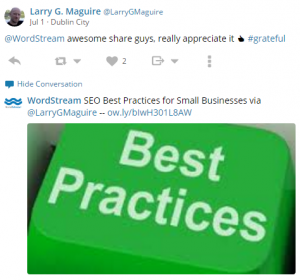— November 13, 2018
Here comes the end of the year and with it countless executive road shows criss-crossing the country to get in front of the employees. You’ll stuff them all in a lunchroom or a foyer, maybe a sad hotel meeting room or a drafty church basement. The chairs will be a bit too close, the room will be too hot or too cold. The employees at the back won’t be able to hear. The slides will be illegible and the whole thing will run 30 to 40 minutes long.
Then you’ll round up your executives, shove them on a plane and start over in a different town. That sucks. In fact, the whole road show probably sucks and so do all the town hall meetings. In fairness, they’ve always sucked and you’re not alone. Here are five reasons I think the vast majority of employee town hall meetings suck, and a few ideas to make them better.
Denial of Town Hall Suckiness
The underlying reason most employee meetings are terrible has a lot to do with a river in Egypt: that’s right, you and your executive team are in a chronically convenient state of denial. I’ll bet that following even the most dismal town hall, your CEO or CFO or whomever says something like “that went pretty well, didn’t it?”. To which you reply, “looked good to me,” or “nice full house” or “sure were a lot of questions.” But none of those things are indicators of whether or not the meeting was a success. To your executives, maybe just getting out of the room alive is good enough, but if the intention of the town hall is to inform, engage, involve and listen to employees, then you have probably missed the mark again this time.

What’s that? Oh, you did a survey. Well that’s good. You asked helpful things like, “how much of this information was new?” “Please rate how applicable the information is to your role.” “Do you understand our priorities for the next quarter?” And things like that. On this basis you probably got 70 or 80 percent in the top two boxes.
But that doesn’t mean your meeting didn’t suck. You’re just not looking at the right metrics. How about asking things like:
- Was this a good use of your time?
- Do you feel like the presenters understand what is happening in your location?
- Did you have a chance to participate in the planning?
- Did you have the opportunity to ask a question?
- Were your top concerns addressed?
- Would you rather chew tin foil than attend a meeting like this again?
If you are working under the assumption that you know what you’re doing and your town hall meeting format, location, agenda and all that is just peachy, try mixing up the questions a little bit to get out of your confirmation bubble.
Way Too Much Material for One Town Hall
I have managed more employee town halls than is decent for one lifetime, and I can say with certainty that I have never, not once, ever had too little material. Maybe a handful of times I have had just the right amount. But mostly I have had way too much material for the time allotted.
The reasons for this are basically a lack of planning and a lack of preparation. We’ll deal with the agenda bloat problem later.
Our executives watch the same TedTalks we do. They see the same helpful blog posts and LinkedIn shares about how to have killer slides like Seth Godin does. They know they should put big fonts, few points, lots of images and amusing builds. They know they should think really, really hard about their key messages and focus on the most effective way to communicate them.
They also know they should be rehearsing because the trick with cool slides, is you have to know how to talk to them and fill in the blanks with stories and humour and authentic noises.
Knowing and doing are, of course, different. At the end of the day what invariably happens is they do neither of those things. When you haven’t thought through how you’re going to communicate, and you haven’t taken the time to practice it until it’s tight, your only option is to put absolutely every point, number, fact and chart on those damn slides and walk us tediously through them.
I have two ideas on this one: First, you should be recording your town halls (more on why below). Armed with evidence of the wretched experience an unprepared, unplanned speaker can unleash, perhaps you can use this as a “game tape”, like a football coach, to improve things next time. If your executives have their own coaches, this would be a great tool for them.
The second tactic I will offer you is one I learned many years ago: Know five numbers (maybe four). This clips the wings of CEOs and CFOs who desperately want everyone to understand the balance sheet as well as they do.
Get your execs to pick four or five key metrics, such as revenue, customer churn, operating expense or market share and talk just to those. Having 80 percent of your employees conversant in a handful of metrics is much better for all concerned than having a handful of employees conversant in all of them. Five numbers, one slide, three minutes and you’re done.
Way Too Many Speakers
It starts out well enough. We decide we want an hour of stuff and half an hour of questions. We put an agenda together and circulate it to the rest of the leadership team and, just like magic, we get silence. So we put an outline together and circulate it to the rest of the leadership team. Silence. Great! Let’s build that deck. No problem to get through this sucker in an hour. We circulate it to the leadership team. We’re now about two weeks out.
All of a sudden, we stop being a wooden road show and, like Pinocchio, we become a Real road show. Suddenly the VP of operations needs 15 minutes on the agenda to discuss some initiative that is running horribly late. Out of nowhere, the person from sales needs 10 minutes to wave the flag, and the marketing leader wants to screen the new creative campaign, while HR just can’t live without taking everyone through some diversity reminders. But that CEO is not giving up her 25 minutes of strategic vision stuff, and that CFO has a whole budget, now, to take everyone through.
I totally understand that all our executives want their moment in front of the employees, and we certainly don’t want each of them to stage their own dreadful series of town halls. So let’s somehow squeeze a little, talk faster, put up more charts and make it work.
You know what that looks like. That’s where illegible slides with spreadsheets cut and pasted into them replace the high design we started with. That’s where the Q&A goes from 30 to 10 minutes and the runtime edges up toward 2 hours.
But what do we do when leadership teams would rather bore our employees senseless than compromise? Video. Make videos. Millennials are about half the workforce these days, and they are good at video. If some leader has something sooooo urgent to get in front of employees, go make a nice video with them. It’s cheaper than an airfare and you can push it out just ahead of or just after the main event. Your entire leadership team does not have to travel as a pack just to wave at employees.
You Cheaped-Out on the Location
Wasn’t this the time by which we were supposed to be able to do town halls virtually? I don’t know if you’ve tried one of those on any scale, but I can tell you we are not yet there. Sure, we can probably broadcast well enough without taking out the entire network (but nobody’s brave enough to try that one), but the whole interactive thing leaves much to be desired when it’s done with thousands of people.
For now at least we’re stuck with physically putting executives in front of real employees. An unfortunate reality of most town halls is that there is no budget. These things are rarely an actual line item in anyone’s budget, which means that any expenses that don’t tuck neatly into travel and entertainment are a problem.
The first thing to go is the space. “We don’t need a meeting space; we’ll use the lunchroom/stairwell/warehouse/parking lot/boardroom. It’ll be fine.”
No, it won’t.
It will suck. It will be too small. It will be the wrong temperature. The sound will be awful. The projector won’t work. The site lines will be horrible. Someone will be frying onions in the cafeteria. There will be background noise. There will be squealing audio feedback. It will be awful for everyone. As they exit the “stage” the leaders will say to you, one by one, “maybe next year we need a better space.”
Let’s lay this out: With airfare, moderate hotel, meals, taxis and incidentals, it costs around $ 10,000 to $ 15,000 to take three executives to three cities on the other side of Canada. Given that outlay, why is it not possible to find a few hundred bucks for a decent meeting room, another few hundred for a professional AV person, and a hundred or so for two screens and working projectors?
Here’s a tip: If you have a real AV company, they can also make the video recording and an MP3 audio file you can use as a podcast. Just saying.
If you happen to have internal space big enough to comfortably hold everyone, then go ahead and splurge on an outside AV company to help you make it not horrific. If you have a good space that’s not quite big enough, consider holding the meeting twice (executives hate that, but I’ve done it and it works).
You Are Not Respecting Your Employees’ Time
Many town hall meetings are held first thing in the morning. Attendance tends to be much better when people aren’t being asked to leave their desks. Cool. For your executives, that means in the meeting room at 8:00 for an 8:30 start.
For your employees that means dropping the kids off half an hour early or negotiating with a spouse or neighbor to get them to school or daycare. It may mean driving instead of taking transit. It may mean taking transit but leaving a full hour early just to make sure they aren’t late.
It also means getting to their work an hour or two after they normally would, though there is little likelihood their deliverables for the day are scaled back to accommodate the two hours they just lost to the sucky town hall.
Maybe you’re doing the town hall during the day. Great. No inconvenience for the family or the commute, but you are asking them to carve out between 20 and 25 percent of their workday; more if they have to go offsite. That’s a big chunk of time.
Given that we have inconvenienced and/or interrupted our employees, I kind of think we owe them some basic courtesies. For example, if you have a first thing in the morning meeting, you owe your employees a warm cup of lousy coffee or tea at the very least. I suggest you also spring for some muffins or yogurt. Yes, it’ll probably be awful, but at least you’re acknowledging that you are imposing on their morning routines.
If you are having it over lunch, order the damn pizza. See above. At the very least, give them some water to drink.
And most of all, let them actually participate. Leaving ten minutes to answer a bunch of planted questions is not participation. Your presenters need to leave time in their talks to ask questions of the audience, gauge interest and sentiment and answer questions on the fly.
Technology is your friend on this one. You can do real-time surveys with tools such as Mentimeter, so nobody has to look like “that person” when there’s a tough question. I’ve used text messaging to create a live “chat” during presentations. Employees texted me their comments, feedback and questions and I typed them up on a screen (the polite ones) so the executives could react in real time.
Did I mention remote workers? What about non-desk workers? Most town hall meetings are designed around people who work from an office. As more of the workforce works from home, you need a strategy to get these folks involved. Same goes for the Undesked. How will your field staff, retail people or manufacturing employees get some town hall love?
This is where your investment in professional video pays off, by the way. There is nothing more disrespectful than expecting an employee to watch 90 minutes of iPhone video shot by an intern in the 8th row.
Rethinking Town Halls
There are lots of tips and tricks for great town halls, but I think a good way to think about them is in terms of how you would do it if the audience were your customers. Would you subject your customers to the indignities of unprepared speakers, lousy slides and uncomfortable rooms? I hope not. Here are the basics:
- Respect their time
- Deliver a professional, rehearsed presentation
- Resist agenda bloat
- Keep the number of speakers to a minimum
- No crappy slides nobody can read
- Pay for a decent, comfortable space
- Ask for (and receive) honest feedback
- Debrief afterward, ideally with video, and try to learn something
- Use technology to include remote participants
Business & Finance Articles on Business 2 Community
(76)






